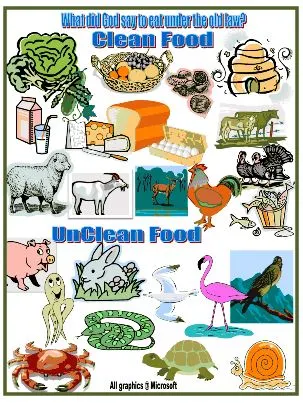Clean and unclean foods in the Bible and ancient Near East (Leviticus 11)
The rationale behind the designation of certain creatures as “clean” and others as “unclean” for dietary purposes (Leviticus 11, cf. Deuteronomy 14:3-21) has perplexed Bible readers thoroughout the ages. Possible explanations include:
- Hygienic reasons (e.g. the fact that pork, especially if not thoroughly cooked, could prove unhealthful and carry disease)
- Allegorical reasons (the notion that the character of certan animals determined whether or not they were clean – e.g. pigs were thought to exemplify lazy, gluttonous, uncouth behaviour and thus were deemed unclean)
- Arbitrary testing (the idea that God randomely designated some animals as unclean in order to test His people’s obedience)
- Pagan association (the suggestion that animals labelled “unclean” were those used in non-Israelite rituals – e.g. certain pagan rituals entailed the sacrifice of pigs)
- Conformity to an ideal (the supposition that only those animals conforming to what was considered “normal” for their species were “clean” – e.g. sea creatures without fins and/or scales were abnormal and therefore unclean)
- Heavenly analogy (the notion that “clean” animals constituted God’s own “diet”)
Some of these explanations are plainly far-fetched; indeed, the suggestion that certain foods comprise God’s own diet lacks any merit. It is important to note, however, that all of them are hypothetical, unsupported by any specific Biblical teaching. Also, none fully accounts for the distinctions detailed in Leviticus 11. Regardless of which hypothetical rationale, if any, historians may offer for the diet of the ancient Israelites, clearly the distinction between clean and unclean foods ensured them a healthful diet and enabled them to maintain their identity as God’s covenantal people (Daniel 1). Adherence to these food laws consecrated the Israelites, setting them apart as holy, just as Yahweh, their God, is holy (Leviticus 11:44-47).
Although outside ancient Israel there is no known system as comprehensive in differentiating between permitted and prohibited foods, dietary restrictions of one kind or another are attested in the ancient Near East from Egypt to Babylonia. Inscriptions in Egyptian temples include lists of food (mostly animal products) certain groups of people were not to eat. The cow, for instance, was off limits in Dendera, where the goddess Hathor was said to be manifested in bovine form. In Mesopotamia, eating certain animals was prohibited on special occasions, such as rituals in which pigs were sacrificed (otherwise, pork was widely eaten). Numerous ancient cults also had specific taboos regarding foods consumption (cf. Colossians 2:20-21).
—
